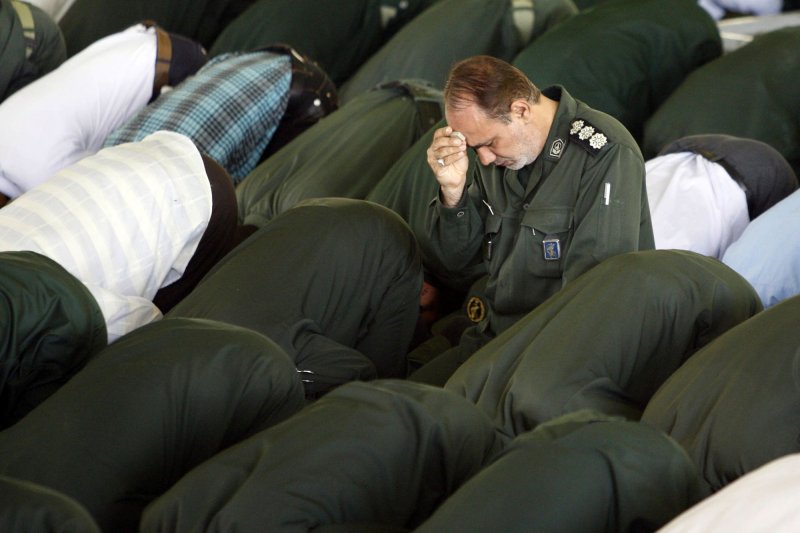1 of 2 | A member of Iranian elite revolutionary Guard attends Friday prayers at Tehran university campus on July 16,2010 in Tehran,Iran. UPI/Maryam Rahmanian |
License Photo
BEIRUT, Lebanon, Oct. 4 (UPI) -- The recent appointment of a top commander of Iran's Revolutionary Guards as oil minister underlines the growing political and economic power of that elite force at a time when U.S. influence in the region is waning and U.S. forces are quitting Iraq.
"The Revolutionary Guards Corps is seizing control of all branches of government," declared Ali Alfoneh of the American Enterprise Institute in Washington and a leading expert on the organization known in Farsi as the Pasdaran.
And there's no sign of this ongoing accumulation of power slowing down.
One of the possible candidates to succeed President Mahmoud Ahmadinejad, a former IRGC officer himself, in the 2013 elections is Brig. Gen. Qassem Suleimani, shadowy commander of the al-Quds Force, the covert action arm of the Islamic Revolutionary Guards Corps.
Suleimani's clandestine force formed "Special Groups" of Shiite militiamen who fought the Americans in Iraq and it effectively runs Hezbollah, Iran's most prized proxy in the Arab world, in its conflict with Israel.
Two other potential candidates in the presidential elections, Parliament Speaker Ali Larijani and Tehran Mayor Mohammad-Baqer Qalibaf, are former Revolutionary Guards officers.
The IRGC's tentacles are spreading amid political upheaval that has been roiling Iran since Ahmadinejad's widely disputed election for a second four-year term in June 2009.
The organization, formed by the late Ayatollah Ruhollah Khomeini as the ideological guardians on the Islamic revolution that toppled Shah Mohammad Reza Pahlavi in January 1979, has become the most powerful force in Iran.
It has accelerated its rise during Ahmadinejad's tenure as president that began in 2005.
The appointment of Rostam Qassemi as oil minister in August, giving the Pasdaran control of the government's key economic position, underlined just how powerful the 120,000-strong IRGC has become.
Before his appointment, Qassemi was head of the IRGC's economic arm, the Khatam ol-Anbia, which has become the leading engineering and construction group in Iran and has been accumulating an ever-greater share of oil and gas revenues.
Securing the Oil Ministry consolidated the Pasdaran's hold on Iran's economic lifeline and with it immense political influence.
This is causing growing unease in many quarters, leading critics to talk darkly of a "state within a state" and the possibility of a military takeover by the Pasdaran, who constitutionally are answerable only to Khomeini's successor as supreme leader, Ayatollah Ali Khamenei.
The IRGC's growing involvement in politics, not to mention the economy, has thrust it into the vortex of the current political turmoil in which Ahmadinejad is locked in a power struggle with the deeply entrenched conservatives of the clerical leadership led by Khamenei.
In recent months, the Pasdaran has come down firmly on the side of the supreme leader, who is seeking to clip the presidential powers that Ahmadinejad appears bent on expanding.
Ahmadinejad's appointment of Qassemi as oil minister is widely seen as a stratagem to woo the IRGC on his side in what could be a looming showdown between the two main political power centers.
Iran's constitution limits any president to two consecutive terms so the fiery Ahmadinejad cannot run again in 2013.
But if he can secure the presidency for one of his allies, such as a key figure in the Pasdaran, the IRGC could become even more powerful.
Parliamentary elections next March could indicate how the presidential poll will play out.
In recent weeks, Khamenei has warned that next spring's legislative ballot could pose serious security risks and has called for national unity.
The last thing the leadership wants is a rerun of the 2009 unrest, when huge protests by an electorate increasingly disenchanted with clerical rule, injustice and corruption erupted across the country.
The protests were ruthlessly crushed by the IRGC and other security forces.
But the biggest test will be who will succeed Khamenei, who is 72 and not in the best of health.
The Middle East Economic Digest observed that Iran "is facing the most turbulent time in its history since the 1979 Islamic revolution, as the authorities struggle to contain protests and political divisions."
If Khamenei dies in office, it said, "there is a real chance previously suppressed protesters will use the resulting vacuum to rise up against the regime."
There seems little doubt that if that happens, the Pasdaran will be the deciding factor.





